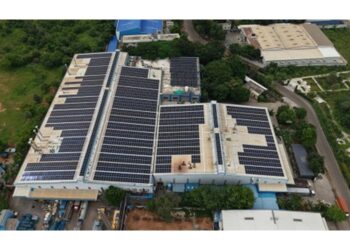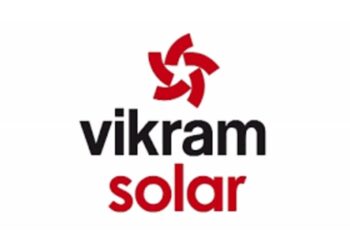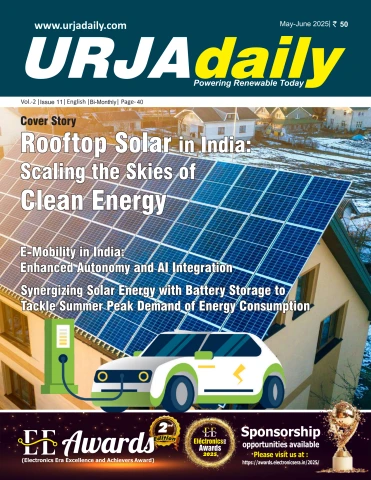Washington DC – A review by the SUN DAY Campaign of data very belatedly released by the Federal Energy Regulatory Commission (FERC) reveals that the combination of solar and wind accounted for almost 91% of new U.S. electrical generating capacity added in the first five months of 2025. In May, solar provided 59% of new capacity, making it the 21st consecutive month in which solar has held the lead among all energy sources.
Solar was 59% of new generating capacity in May and 75% year-to-date:
In its latest monthly “Energy Infrastructure Update” report (with data through May 31, 2025), FERC says 43 “units” of solar totaling 1,515 megawatts (MW) were placed into service in May, accounting for 58.7% of all new generating capacity added during the month.
The new facilities included the 305.1-MW Bright Arrow Solar & Storage Project in Hopkins County, TX; the 300-MW Papago Solar & Battery Storage Project in Maricopa County, AZ; the 250.0-MW Fairbanks Solar Energy Center in Sullivan County, IN; and the 200.0-MW Green River Solar Project in Meade County, KY.
The 11,518-MW of solar added during the first five months of 2025 was more than three-quarters (75.3%) of the total new capacity placed into service.
Solar has now been the largest source of new generating capacity added each month for twenty-one consecutive months: September 2023 – May 2025.
Solar + wind were nearly 91% of new capacity added in the first five months of 2025:
Between January and May, new wind has provided 2,379-MW of capacity additions, thereby accounting for 15.6% of all new capacity added during the first five months of 2025. In May alone, Prairie Switch Wind LLC’s 163.2-MW Crawfish Wind Project in Wharton County, TX came on-line along with Airstream LLC’s 33.6-MW Mesa Wind Developers Project in Riverside, CA.
For the first five months of the year, the combination of solar and wind was 90.9% of new capacity while natural gas (1,381-MW) provided just 9.0%; the remaining 0.1% came from oil (14-MW).
Solar + wind are almost a quarter of U.S. utility-scale generating capacity; all renewables combined are nearly a third:
The installed capacities of solar (11.1%) and wind (11.8%) are now each more than a tenth of the nation’s total. Taken together, they constitute almost one-fourth (22.9%) of the U.S.’s total available installed utility-scale generating capacity.
Moreover, at least 25-30% of U.S. solar capacity is in the form of small-scale (e.g., rooftop) systems that are not reflected in FERC’s data. [1] Including that additional solar capacity would bring the share provided by solar + wind to more than a quarter of the nation’s total.
With the inclusion of hydropower (7.7%), biomass (1.1%) and geothermal (0.3%), renewables currently claim a 32.0% share of total U.S. utility-scale generating capacity. If small-scale solar capacity is included, renewables are now about one-third of total U.S. generating capacity.
Solar remains on track to become the second largest source of U.S. generating capacity:
FERC reports that net “high probability” additions of solar between June 2025 and May 2028 total 89,513-MW – an amount almost four times the forecast net “high probability” additions for wind (23,019-MW), the second fastest growing resource.
FERC also foresees net growth for hydropower (596-MW) and geothermal (92-MW) but a decrease of 123-MW in biomass capacity.
Taken together, the net new “high probability” capacity additions by all renewable energy sources over the next three years – i.e., the bulk of the Trump Administration’s remaining time in office – would total 113,097-MW.
On the other hand, there is no new nuclear capacity in FERC’s three-year forecast while coal and oil are projected to contract by 24,913-MW and 1,907-MW respectively. Natural gas capacity would expand by 5,992-MW.
Thus, adjusting for the different capacity factors of gas (59.7%), wind (34.3%), and utility-scale solar (23.4%), electricity generated by the projected new solar capacity to be added in the coming three years should be nearly six times greater than that produced by the new natural gas capacity while the electrical output by new wind capacity would be more than double that by gas. [2]
If FERC’s current “high probability” additions materialize, by May 1, 2028, solar will account for over one-sixth (16.7%) of the nation’s installed utility-scale generating capacity. Wind would provide an additional one-eighth (12.7%) of the total. Thus, each would be greater than coal (12.2%) and substantially more than either nuclear power or hydropower (both 7.2%).
In fact, assuming current growth rates continue, the installed capacity of utility-scale solar is likely to surpass that of either coal or wind within two years, placing solar in second place for installed generating capacity – behind only natural gas.
The combined capacities of all renewables, including small-scale solar, may overtake natural gas within three years:
The mix of all utility-scale (i.e., >1-MW) renewables is now adding about two percentage points each year to its share of generating capacity. At that pace, by June 1, 2028, renewables would account for three-eighths (37.8%) of total available installed utility-scale generating capacity – rapidly approaching that of natural gas (40.2%). Solar and wind would constitute more than three-quarters of the installed capacity of renewable sources. If those trendlines continue, utility-scale renewable energy capacity should surpass that of natural gas in 2029 or sooner.
However, as noted, FERC’s data do not account for the capacity of small-scale solar systems. If that is factored in, within three years, total U.S. solar capacity (i.e., small-scale plus utility-scale) should exceed 300-GW. In turn, the mix of all renewables would then be about 40% of total installed capacity while natural gas’ share would drop to about 38%.
Moreover, FERC reports that there may actually be as much as 226,821-MW of net new solar additions in the current three-year pipeline in addition to 67,405-MW of new wind, 9,064-MW of new hydropower, 202-MW of new geothermal, and 34-MW of new biomass. By contrast, net new natural gas capacity potentially in the three-year pipeline totals just 28,797-MW. Consequently, renewables’ share could be even greater by late-spring 2028.
Evidence of the energy transition is already clear as renewables’ share of generating capacity continues to increase while that of fossil fuels and nuclear power shrinks:
At the end of 2024, the mix of all renewables accounted for 30.96% of total generating capacity. Solar alone was 10.19% while wind was 11.68%. In just five months – i.e., by the end of May, renewables’ share had risen to 31.98% with solar at 11.13% and wind at 11.80%.
On the other hand, natural gas’ share had slipped from 43.00% to 42.52% as coal fell from 15.30% to 14.89% and oil dropped from 2.73% to 2.72%. Similarly, nuclear power’s share of generating capacity decreased from 7.84% to 7.74%.
“FERC’s latest data predate enactment of the Trump Administration’s ‘Big, Beautiful Bill’ which may adversely affect the future growth trajectories of wind and solar,” noted the SUN DAY Campaign’s executive director Ken Bossong. “However, FERC’s forecasts suggest that cleaner and lower-cost renewable energy sources will continue to grow, retaining their lead over coal and nuclear power while closing the gap with natural gas.”













